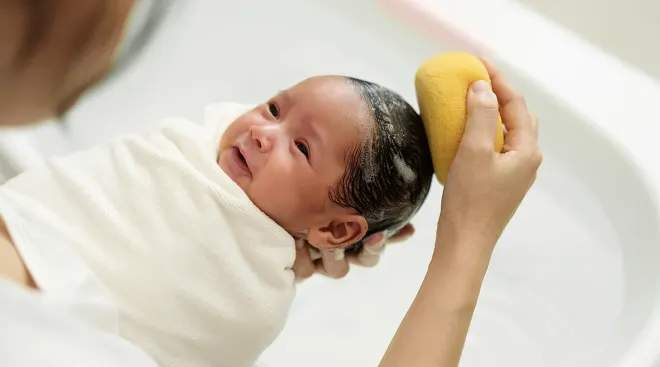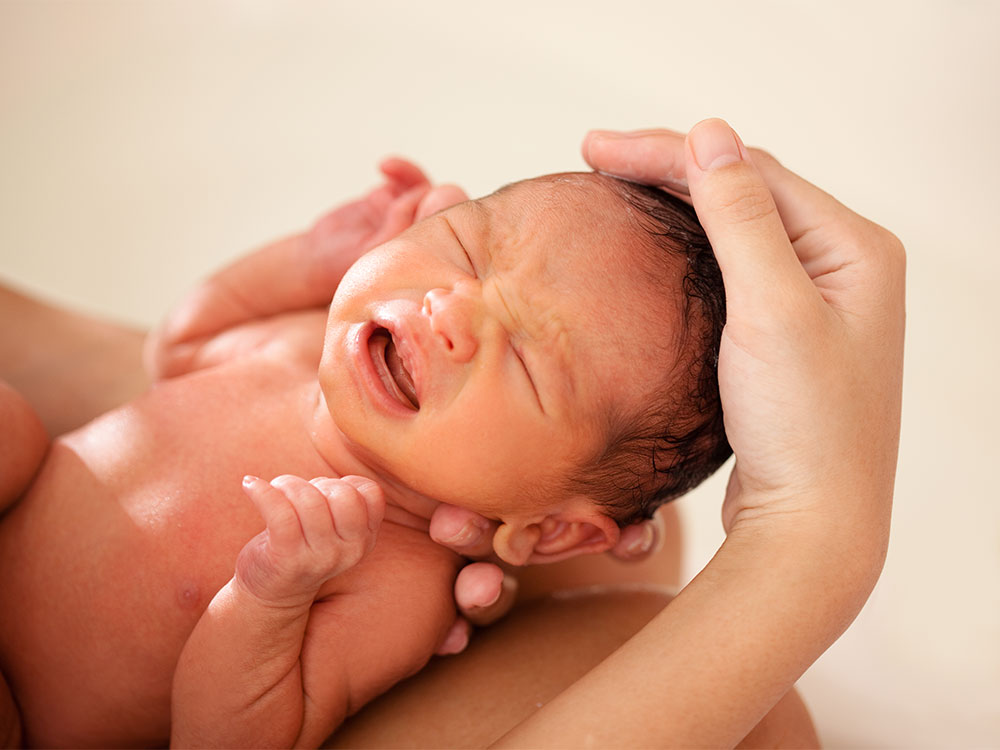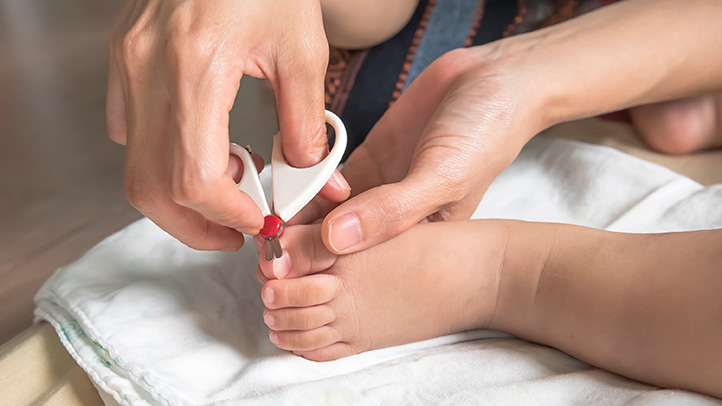To bathe a newborn, fill a small tub with warm water and gently wash the baby using mild soap. Support the baby’s head and neck throughout the bath.
Bathing a newborn can seem daunting for new parents. It’s important to ensure the baby feels safe and comfortable. Start by gathering all necessary supplies, including a baby tub, mild baby soap, soft washcloths, and towels. The water should be warm but not hot, ideally around 37°C (98.
6°F). Always keep one hand on the baby for support, particularly under the head and neck. Use gentle, circular motions to clean the baby’s skin, avoiding the eyes and face. After the bath, wrap the baby in a warm towel and gently pat dry. Bathing should be a soothing experience for both the baby and the parent.
Preparing For The Bath
Before you start bathing your newborn, it’s important to prepare. This ensures everything goes smoothly and safely. Let’s dive into the steps for a stress-free bath time.
Gather Supplies
Gather all the necessary supplies before starting the bath. This helps avoid any interruptions. Here’s a list of things you will need:
- Soft washcloths
- Baby soap and shampoo
- Hooded towel
- Clean diaper
- Fresh clothes
- Baby bathtub or a sink
Having everything within arm’s reach is crucial. You should never leave your baby unattended.
Choose The Right Time
Choosing the right time for the bath is key. Pick a time when your baby is calm and alert. Avoid bath time right after feeding. Your baby might spit up if bathed too soon after eating.
Many parents prefer evening baths. This can help relax the baby before bedtime. Find a time that fits your routine best.
Make sure the room is warm. Babies can get cold quickly. A comfortable room temperature is around 75°F (24°C).
Setting Up The Bath Area
Bathing a newborn can feel overwhelming. Proper setup of the bath area helps. This section guides you through the essential steps.
Select A Safe Location
Choose a location near a water source. A bathroom or kitchen works best. Ensure the area is clean and free of clutter. Safety is the top priority. Use a non-slip mat if needed. Keep all bath items within arm’s reach.
Adjust Room Temperature
Newborns are sensitive to temperature. Adjust the room temperature to around 75°F (24°C). This helps keep your baby comfortable. Close windows and doors to avoid drafts. Warm towels and clothes should be ready for after the bath.
Below is a quick checklist for setting up the bath area:
- Safe location: Near water, clean, clutter-free
- Non-slip mat: Prevents slipping
- Room temperature: 75°F (24°C)
- Warm towels: Ready for use
- Clothes: Warm and close by
Ensure you have everything ready before starting. This makes the bathing process smoother and safer for your newborn.
Filling The Bath
Bathing a newborn can be a joyful experience. Proper preparation is essential to keep your baby safe. The first step is filling the bath. Follow these simple steps to ensure a safe and comfortable bath for your little one.
Use Warm Water
Always use warm water, not hot. The water should feel comfortable on your wrist. Aim for a temperature around 37°C (98.6°F). You can use a bath thermometer for accuracy.
Check Water Level
Fill the tub with just a few inches of water. The water level should be about 2-3 inches deep. Too much water can be dangerous.
| Water Temperature | Water Level |
|---|---|
| 37°C (98.6°F) | 2-3 inches |
Following these simple steps can ensure a safe and enjoyable bath time. Always keep an eye on your baby and never leave them unattended in the bath.

Credit: www.pregnancybirthbaby.org.au
Undressing The Baby
Undressing a newborn can seem challenging. With a few simple steps, you can make it easier. Remember to keep your baby comfortable throughout the process.
Remove Clothing
Start by gently laying your baby on a safe, flat surface. Use a changing table or a soft towel on the floor. Unbutton or unzip their outfit carefully. If your baby is wearing a onesie, unfasten the snaps at the bottom first. Then, slide the clothing off one arm at a time.
Move slowly to avoid startling your baby. Keep talking to them in a soothing voice. This helps them feel secure and calm.
Keep Baby Warm
Newborns can get cold quickly. Use a soft blanket to cover parts of the baby not being undressed. You can also turn up the room temperature slightly. This keeps your baby warm and comfortable.
| Step | Action |
|---|---|
| 1 | Lay the baby on a safe, flat surface |
| 2 | Unbutton or unzip the outfit |
| 3 | Unfasten the snaps of the onesie |
| 4 | Slide clothing off one arm at a time |
| 5 | Cover exposed parts with a soft blanket |
By following these steps, you ensure your baby stays warm. A warm baby is a happy baby.
Placing Baby In The Bath
Bathing a newborn can be a joyful experience for parents. It is important to handle your baby carefully. The right techniques ensure safety and comfort for your little one. Let’s explore how to place your baby in the bath.
Support The Head
Always keep your baby’s head supported. Use one hand to gently cradle the head and neck. This support prevents the baby’s head from slipping under water. It also makes your baby feel secure and calm.
Lower Gently
With the head supported, use your other hand to hold the baby’s bottom. Slowly lower the baby into the bathwater. Ensure that the baby feels the water gradually. This helps the baby adjust to the water temperature.
Keep the water level low. The water should cover only the baby’s legs and bottom. This reduces the risk of accidental drowning and keeps the baby warm.
| Steps | Details |
|---|---|
| 1. Support the Head | Use one hand to cradle the head and neck. |
| 2. Hold the Bottom | Use your other hand to hold the baby’s bottom. |
| 3. Lower Gently | Slowly lower the baby into the water. |
| 4. Adjust Water Level | Ensure water covers only legs and bottom. |
Always stay with your baby during bath time. Never leave the baby unattended, even for a second. This ensures your baby’s safety and well-being.

Credit: www.thebump.com
Washing The Baby
Bathing a newborn can be a delicate process. It is important to ensure that every step is gentle and safe. Below, we will explore how to wash your baby effectively, focusing on key areas to ensure a thorough and comfortable bath.
Use Gentle Soap
Always opt for gentle soap when bathing your newborn. Harsh soaps can irritate the baby’s sensitive skin. Choose a soap that is fragrance-free and hypoallergenic. This helps prevent skin reactions.
Here is a simple checklist for choosing the right soap:
- Fragrance-free
- Hypoallergenic
- Dermatologist-tested
Clean One Area At A Time
When washing your baby, focus on one area at a time. This ensures that each part is cleaned thoroughly without overwhelming the baby.
Follow these steps for a structured cleaning process:
- Start with the head and face.
- Move to the neck and chest.
- Clean the arms and hands.
- Wash the legs and feet.
- Finish with the diaper area.
Use a soft washcloth to clean each area. Wet the cloth with warm water and gently wipe the baby’s skin. Avoid scrubbing too hard.
Here is a table summarizing the key points:
| Step | Description |
|---|---|
| 1 | Start with the head and face |
| 2 | Move to the neck and chest |
| 3 | Clean the arms and hands |
| 4 | Wash the legs and feet |
| 5 | Finish with the diaper area |
By following these steps, you can ensure a safe and comfortable bath for your newborn. Remember, the key is to be gentle and thorough.
Rinsing And Drying
Bathing a newborn can be a delicate task. After washing your baby, it’s crucial to rinse and dry them properly. This ensures their comfort and health. Follow these steps to make sure your baby feels fresh and clean.
Use Clean Water
Always rinse your baby with clean water. Fill a small cup or use a handheld shower. Make sure the water is warm, not hot. Pour the water gently over your baby’s body.
Pay attention to the creases in their skin. Rinse off any soap thoroughly. This helps prevent skin irritation. Be gentle around sensitive areas like the face and neck.
Pat Dry With Towel
After rinsing, wrap your baby in a soft towel. Use a towel that’s big enough to cover them completely. Pat dry your baby gently. Do not rub their skin.
Focus on drying the skin folds. Areas like under the arms, behind the ears, and in the diaper area. Make sure your baby is completely dry before dressing them.
| Step | Action |
|---|---|
| 1 | Use clean water to rinse. |
| 2 | Be gentle, especially around the face. |
| 3 | Pat dry with a soft towel. |
| 4 | Focus on skin folds. |
- Ensure water temperature is warm.
- Use a big enough towel.
- Dry all skin creases.
Proper rinsing and drying keep your baby comfortable and healthy. Follow these steps for a happy bath time experience.

Credit: raisingchildren.net.au
Post-bath Care
Once your newborn’s bath is complete, it’s essential to focus on Post-Bath Care. This step ensures your baby stays comfortable, warm, and well-moisturized. Proper post-bath care can prevent skin issues and keep your baby happy.
Apply Lotion
Gently pat your baby dry with a soft towel. Avoid rubbing the skin to prevent irritation. Use a mild, baby-friendly lotion to keep the skin moisturized. Apply the lotion evenly over the baby’s body. Focus on areas prone to dryness, such as elbows and knees.
Dress In Fresh Clothes
Choose soft, breathable clothes for your baby. Ensure the clothes are clean and free from any harsh chemicals. Dress your baby in layers to keep them warm and cozy. Make sure the clothing is not too tight to allow for easy movement.
Frequently Asked Questions
When Should A Newborn Have Their First Bath?
A newborn should have their first bath 24 to 48 hours after birth. This allows the baby’s skin to adjust.
How To Take A Bath For A Newborn Baby?
Fill a baby tub with 2-3 inches of warm water. Hold your baby securely. Gently wash with mild baby soap. Rinse thoroughly. Pat dry with a soft towel.
How To Bathe A Newborn With An Umbilical Cord?
To bathe a newborn with an umbilical cord, use a sponge bath. Keep the cord dry and clean. Gently wipe the baby’s body with a soft, damp cloth. Avoid submerging the baby in water until the cord falls off. Ensure the bathing area is warm and safe.
Should You Bathe A Newborn With Just Water?
Yes, you can bathe a newborn with just water. Their skin is sensitive and plain water is gentle.
Conclusion
Bathing a newborn can be a rewarding experience. Follow our tips to ensure your baby stays safe and comfortable. Remember to gather all essentials beforehand. Practice makes perfect, so stay patient and calm. With these steps, you’ll master the art of newborn bathing in no time.
Happy parenting!

